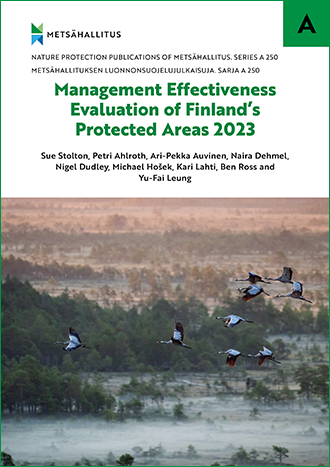Management Effectiveness Evaluation of Finland’s Protected Areas 2023
A comprehensive international assessment of the management effectiveness of Finland’s protected areas was
commissioned by Metsähallitus Parks & Wildlife Finland (PWF) and carried out by an independent expert group
in 2023. The assessment was based on the framework developed by the IUCN World Commission for Protected
Areas (WCPA). The assessment themes were operating context and the state of protected areas, planning,
inputs/resources, process, outputs, and outcomes. The current management of the network was evaluated and
compared with the results of the previous evaluation carried out in 2004.
PWF produced extensive thematic background material and answers to a series of network-level questions
based on the framework, which formed the core of the actual evaluation and report. In addition, an assessment
based on the Management Effectiveness Tracking Tool (METT) was carried out in five protected areas; Summaries
of these are annexed to the report. The evaluation also included a field trip, with visits to the assessed sites and
meetings with representatives of Metsähallitus, organisations and stakeholders.
Management of Finland’s protected areas was assessed as good by international standards. Despite the general
decline in biodiversity, PWF was considered to have achieved its objectives in protecting the conservation values
for which it is responsible in protected areas. However, the evaluation team made a number of recommendations
to improve effectiveness: These are summarised by theme and spelled out question by question.
Vision and alignment: Strengthen the vision on biodiversity and emphasis in communications concerning protected
areas. Develop strategies to address wicked problems such as the impacts of climate change, reindeer
grazing and invasive alien species. Further develop prioritised habitat and species conservation programmes
and indicators to monitor state of protected areas and nature values. Consider wider variety of protected area
types to achieve international conservation objectives, with an emphasis on improving the network in southern
Finland. Continue the adaptive development of PWF operations, taking care to involve staff. Explore opportunities
to broaden the funding base and increase volunteering.
International links: Strengthen the link between PWF activities and global/regional goals and reporting on the
role of protected areas against these goals. Participate actively in the development of reporting methods, e.g.
concerning protected area management effectiveness.
Collaboration and integration: Develop links with research institutions and systematically ensure the use of new
research results to improve the management of protected areas. Strengthen focus on nature and ecosystems in
environmental education. Develop cooperation and participation with communities operating in the vicinity of
protected areas.
Management: Ensure strategic operational steering and staff support in a changing operating environment.
Streamline protected area planning processes, aiming for an adaptive approach. Develop strategies for integrating
climate issues into management planning at site and network level. In planning and communication, place
more emphasis on the ecosystem services and societal benefits provided by protected areas. Develop tourism
cooperation and sustainability management.
Data and management links: Continue to develop internal data systems and knowledge-based management,
as well as interactive external web-based systems, involving staff and customers. Develop a holistic approach
to reporting on the state of protected areas. Integrate the monitoring of biodiversity in protected areas more
closely into the broader long-term monitoring framework in Finland.
Public and key stakeholder engagement: Develop procedures to strengthen the consultation, participation and
custodianship of local communities in protected areas. Monitor the expectations of visitors to protected areas,
in order to maintain satisfaction and anticipate changing pressures. Translate management principles into visitor
and resource management actions on the ground and communicate them effectively.
